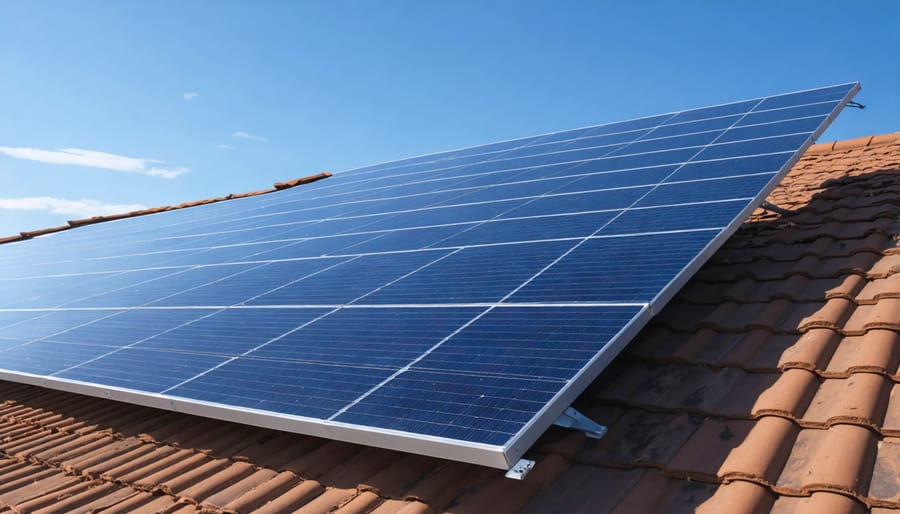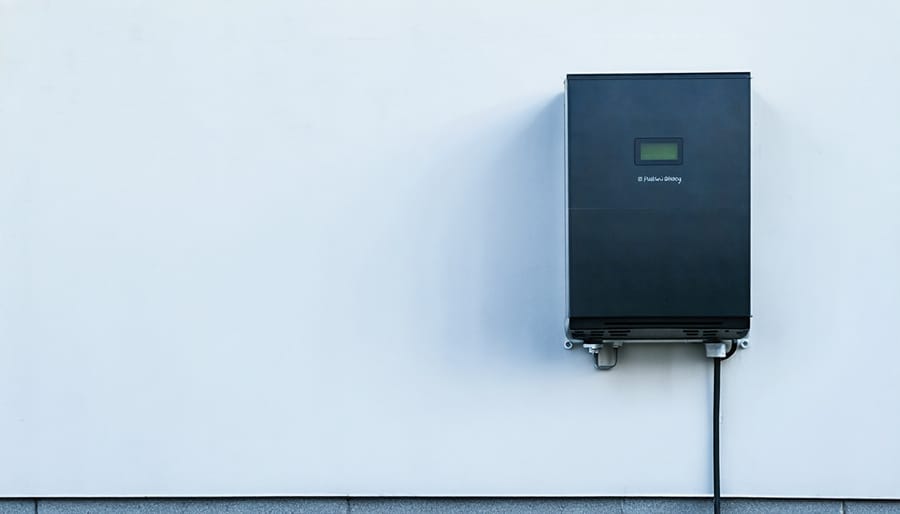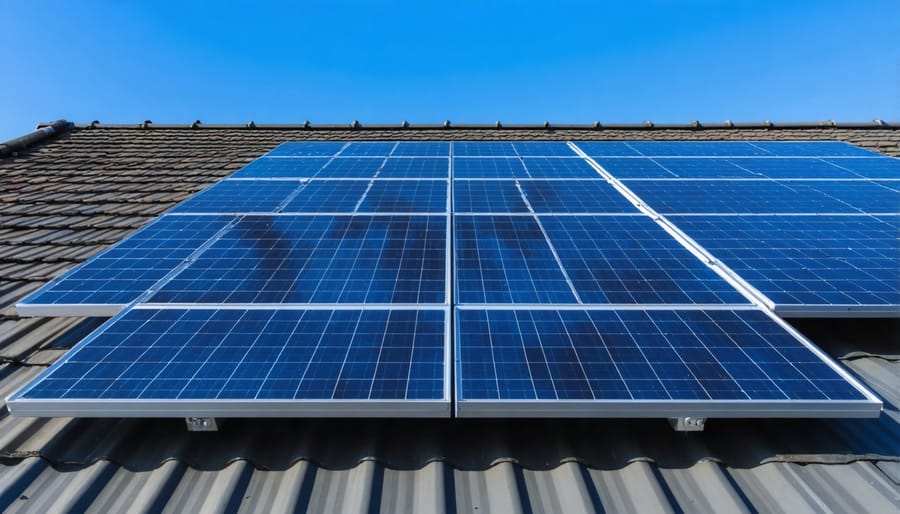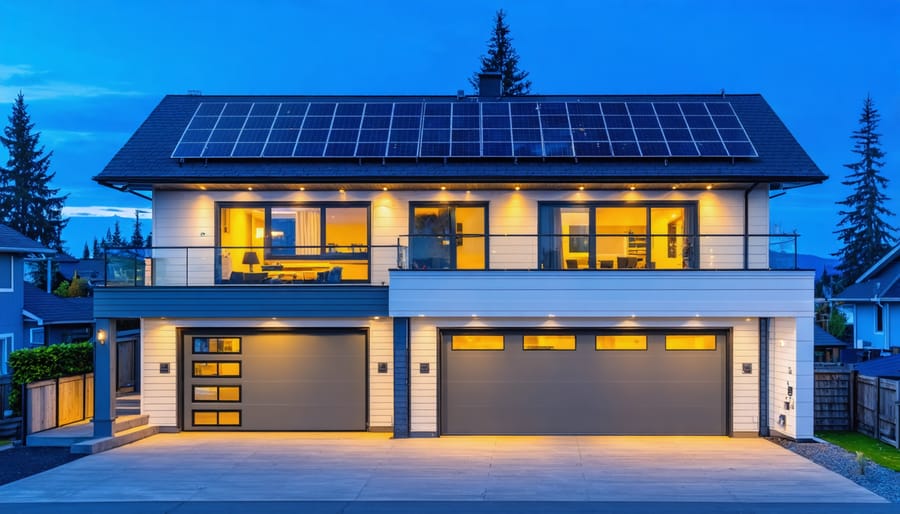**Maximize Your Solar Investment: Why Battery Storage Changes Everything**
Your solar panels generate clean electricity during sunny BC days—but what happens when the sun sets or the grid goes down? Without energy storage, excess power flows back to the grid at minimal credit rates, while you continue paying premium prices for evening electricity. Battery storage systems capture and store your surplus solar energy for use exactly when you need it most.
British Columbia’s evolving net metering policies and increasing electricity rates make battery integration more financially attractive than ever. Modern lithium-ion systems seamlessly connect to existing solar installations, automatically storing daytime generation and releasing power during evening peaks when BC Hydro rates are highest. This means lower monthly bills, backup power during outages, and true energy independence.
Consider a Kelowna family who reduced their annual electricity costs by 73% after adding a 13.5 kWh battery to their existing 8 kW solar array. They now power through evening cooking and laundry with stored solar energy instead of grid electricity, while maintaining backup power for critical appliances during BC’s increasingly frequent weather-related outages.
The technology has matured significantly. Today’s systems offer 10-15 year warranties, smartphone monitoring, and intelligent automation that optimizes when to store, use, or export power based on your consumption patterns and utility rates. For BC homeowners and businesses already generating solar power—or planning to—battery storage transforms panels from a partial solution into a complete energy system that works around the clock.
The Gap in Your Solar System: What Happens When the Sun Goes Down
Solar panels are remarkable at what they do – converting British Columbia’s abundant sunlight into clean electricity. But there’s a catch that every solar homeowner quickly discovers: when the sun sets, so does your power generation.
Here’s how a typical BC household’s energy day unfolds. During sunny afternoons, your solar panels might produce more electricity than you’re using. That excess power flows back to the grid through net metering programs, earning you credits on your utility bill. It’s a great system, but those credits don’t tell the whole story.
The challenge emerges in the evening. Picture your family returning home around 6 PM on a January evening – it’s already dark outside. You’re cooking dinner, running the dishwasher, doing laundry, and streaming your favourite show. Your solar panels? They’re producing zero electricity. Instead, you’re drawing power from the grid and paying the standard rate for every kilowatt-hour.
This pattern repeats throughout BC. In Vancouver, families use approximately 60% of their electricity during evening and morning hours when solar production is minimal or non-existent. During winter months, when darkness arrives by 4:30 PM, this gap becomes even more pronounced.
Net metering helps offset some costs, but you’re still dependent on the grid during your peak usage times. You’re essentially using the grid as your “battery” – storing excess daytime production as credits and withdrawing it later. However, you’re missing the opportunity to use the clean energy you’ve already generated right when you need it most.
This is where the limitation becomes clear: without energy storage, you’re generating green power during the day but consuming grid power at night. Your solar investment is working part-time, when it could be powering your home around the clock.

How Battery Storage Changes Everything
Storing Sunshine for Later
During those beautiful BC summer days, your solar panels often generate more electricity than your home needs. Without storage, this excess power flows back to the grid—and you miss the opportunity to use it when the sun sets. Battery storage systems solve this challenge by capturing that surplus energy during peak sunshine hours.
Think of it like filling a water reservoir during heavy rainfall. Your batteries charge up while the sun shines bright, storing clean energy for later use. When evening arrives and your family settles in for dinner, or on those grey, overcast mornings we know well in BC, your home draws from the stored battery power instead of pulling from the grid.
This means you’re using your own solar energy throughout the day and night, maximizing your investment and reducing reliance on utility power. For example, a Vancouver family with battery storage can power their evening cooking, lighting, and entertainment entirely from sunshine captured earlier that day. The system works automatically, seamlessly switching between solar generation, battery storage, and grid power as needed—giving you energy independence around the clock.
Your Backup Power Solution
When the power goes out, solar panels alone won’t keep your lights on. Without battery storage, your system automatically shuts down during grid outages—a safety feature that protects utility workers but leaves you in the dark. This limitation becomes especially significant during BC’s winter storm season, when heavy snowfall and high winds can knock out power for hours or even days in rural communities.
Integrated battery systems change this equation completely. When the grid goes down, your batteries seamlessly take over, automatically powering essential appliances and keeping your home running. You can prioritize critical loads like refrigerators, heating systems, medical equipment, and lighting, ensuring comfort and safety regardless of what’s happening outside.
For BC residents, this backup capability offers genuine peace of mind. Consider a family in the Kootenays who experienced three multi-day outages last winter. Their solar-plus-storage system kept their heat pump running, their food fresh, and their internet connected while neighbors waited for grid restoration. In the Lower Mainland, a small business owner avoided costly downtime during a windstorm, maintaining operations and serving customers without interruption.
The beauty of modern battery systems is their intelligence. They monitor grid status constantly, charge from your solar panels during the day, and instantly switch to backup mode when needed. Many systems even allow you to customize backup priorities through smartphone apps, giving you complete control over your energy independence during emergencies.
Types of Battery Storage Systems for BC Homes

Lithium-Ion Battery Systems
Lithium-ion batteries have become the go-to choice for BC homeowners integrating storage with their solar systems, and for good reason. These compact, efficient units store excess solar energy during sunny days and release it when you need it most—during evening hours or cloudy periods when your panels aren’t producing.
What makes lithium-ion particularly attractive is their impressive battery storage lifespan of 10-15 years with proper maintenance, often matching or exceeding your solar panel warranty. Most residential systems offer capacity ranges between 10-20 kWh, enough to power essential appliances overnight or during brief outages. You can also stack multiple units to increase storage as your needs grow.
Popular brands available through BC installers include Tesla Powerwall, LG Chem RESU, Enphase IQ Battery, and Sonnen. These manufacturers have established strong service networks in our province, ensuring reliable support when you need it.
Expect to invest between $10,000-$15,000 for a typical 13 kWh system installed, though provincial and federal incentives can significantly reduce upfront costs. While this represents a substantial investment, BC homeowners typically see payback within 8-12 years through reduced electricity bills and increased energy independence.
The real advantage? You’re maximizing your solar investment by using more of the clean energy you generate rather than sending it back to the grid at lower rates than you’d pay for evening power.
AC-Coupled vs. DC-Coupled Systems
When connecting a battery to your solar system, you’ll encounter two main approaches: AC-coupled and DC-coupled systems. Understanding the difference helps you choose the right setup for your situation.
**DC-coupled systems** connect batteries directly to your solar panels before the electricity converts to AC power for your home. Think of it as a more direct path—solar energy flows straight into storage. These systems typically offer slightly higher efficiency (around 4-7% better) because electricity converts fewer times. They’re ideal for new solar installations or complete system upgrades, and they often cost less upfront since they can share components like inverters.
**AC-coupled systems** connect batteries after your solar panels have already converted DC power to AC through your existing inverter. The battery system then converts that AC power back to DC for storage. While this involves an extra conversion step, AC-coupled systems shine for retrofitting existing solar installations. If you already have solar panels producing well, adding an AC-coupled battery preserves your current setup without modification.
For BC homeowners, AC-coupled systems frequently make more financial sense when adding storage to established solar arrays—you keep your existing equipment and warranties intact. A family in Victoria successfully added AC-coupled storage to their 5-year-old system, maintaining their solar production while gaining backup power during winter storms.
New installations benefit from DC-coupled efficiency, especially in off-grid applications common in BC’s rural areas. Your solar installer can assess which approach maximizes your investment based on your current setup and energy goals.
Sizing Your Battery Storage
Determining the right battery size starts with understanding your household’s daily energy use—typically measured in kilowatt-hours (kWh). Most BC homes use between 20-30 kWh daily. Review your electricity bills to establish your baseline consumption.
Next, consider your solar panel output and whether you want partial backup (essential circuits only) or whole-home coverage during outages. A 10-13 kWh battery suits many households seeking backup for refrigeration, lighting, and internet during BC’s occasional power interruptions.
For full energy independence, you’ll need larger capacity—potentially 20+ kWh—but this significantly increases upfront costs. Many BC homeowners start with one battery and expand later as needs evolve or prices drop.
Consider seasonal variations too. BC’s darker winter months mean less solar generation, affecting how much you can store. Our interactive savings calculator helps you model different battery sizes based on your specific situation and goals.
Real Savings: What Battery Storage Means for Your BC Energy Bills
Understanding the financial impact of battery storage is essential for BC homeowners making informed energy decisions. Let’s break down the real numbers behind this investment.
**Time-of-Use Rate Optimization**
BC Hydro’s residential inclining block rate structure means you pay more as you use more electricity. Without battery storage, you’re drawing from the grid during peak consumption hours—typically evenings when solar panels aren’t producing. A battery system shifts this equation dramatically. By storing excess solar energy during the day and using it during evening peaks, a typical BC household can reduce grid consumption by 60-80%, keeping usage within the lower-cost tier and saving $600-$1,200 annually.
**Reduced Grid Dependency**
Battery storage directly translates to fewer kilowatt-hours purchased from BC Hydro. For a home consuming 10,000 kWh annually, a properly sized battery system paired with solar can reduce grid dependency by approximately 7,000-8,000 kWh per year. At current BC Hydro rates, this represents ongoing annual savings of $700-$1,000, and these savings grow as electricity rates inevitably increase over time.
**Long-Term Return on Investment**
A residential battery storage system in BC typically costs between $12,000-$18,000 installed, depending on capacity and brand. With annual savings averaging $800-$1,200 combined from reduced consumption and rate optimization, homeowners can expect payback periods of 12-18 years. While this might seem lengthy, consider that quality battery systems have 10-15 year warranties with expected lifespans beyond 20 years.
The financial picture improves significantly when factoring in available incentives, protection from future rate increases (BC Hydro rates have risen approximately 3% annually), and the added value during power outages—which are becoming more frequent in many BC communities.
**Calculate Your Specific Savings**
Every home’s energy consumption pattern is unique. We’ve developed an interactive savings calculator that considers your actual electricity bills, solar production potential, and household usage patterns to provide personalized projections. This tool gives you realistic expectations based on BC-specific rates and weather patterns.
The Thompsons from Kelowna, for example, discovered through our calculator that their payback timeline was just 14 years, with projected lifetime savings exceeding $18,000. Your results will reflect your specific circumstances, helping you make a confident, informed decision.

BC Success Story: The Thompson Family’s Energy Independence Journey
When the Thompson family of Kelowna installed their 8kW solar panel system in 2019, they were thrilled to reduce their electricity bills and environmental footprint. However, they quickly realized a limitation: their solar power vanished into the grid during sunny days, while they still pulled expensive electricity at night and during winter months.
“We loved generating clean energy, but we weren’t actually using most of what we produced,” explains Sarah Thompson, a graphic designer and mother of two. “When BC Hydro introduced net metering changes, we started looking seriously at battery storage.”
In March 2023, the Thompsons added a 13.5kWh battery system to their existing solar installation. The integration took just two days, with minimal disruption to their daily routine. Their installer coordinated the necessary permits and BC Hydro approvals, making the process surprisingly straightforward.
**Real-World Results After One Year**
The numbers speak for themselves. The Thompson family now uses 78% of their own solar power, up from just 32% before adding storage. Their annual electricity costs dropped by $1,850 compared to their pre-storage bills, and they’re on track to recover their battery investment within nine years.
“Summer is fantastic—we’re essentially off-grid during the day and draw from our battery most evenings,” Sarah notes. “But the real test came last December.”
**Performance During Winter Outage**
When a severe windstorm knocked out power to their neighbourhood for 14 hours in December 2023, the Thompsons barely noticed. Their battery system seamlessly switched to backup mode, keeping their refrigerator, heating system, and essential lights running throughout the outage.
“Our neighbours were at hotels or throwing out spoiled food,” Sarah recalls. “We were warm, had hot meals, and the kids did their homework like nothing happened. That peace of mind alone makes the investment worthwhile.”
The Thompsons’ experience demonstrates how battery storage transforms solar panels from a grid-connected generator into true energy independence.
What to Consider Before Adding Battery Storage
Your Current Solar System Setup
Understanding your existing solar system is essential before adding battery storage. Most modern solar installations in BC are grid-tied systems, which are generally straightforward to retrofit with batteries. However, older systems may require upgrades to inverters or electrical panels.
**Key compatibility factors include:**
Your inverter type matters most. If you have a string inverter, you’ll likely need a separate battery inverter or consider upgrading to a hybrid inverter that manages both solar panels and batteries. Microinverter systems can also accommodate batteries, though the integration approach differs.
The age of your system plays a role too. Systems installed after 2015 typically have more compatible components, while older installations might need additional hardware updates.
**Good news for BC homeowners:** Most solar installers design systems with future battery integration in mind. A qualified solar professional can assess your setup in about an hour, identifying any necessary modifications and providing accurate cost estimates.
The retrofitting process usually takes one to two days, causing minimal disruption. Many BC residents have successfully added storage years after their initial solar installation, increasing their energy independence without major system overhauls.
BC Climate and Seasonal Considerations
British Columbia’s distinct seasonal patterns significantly influence how battery storage systems perform and how you should size them for your home or business. Our province experiences wet, mild winters with limited sunlight and sunny, dry summers with extended daylight hours—this creates unique considerations for energy storage.
During BC’s darker winter months, your solar panels generate less power precisely when you need more energy for heating and lighting. A properly sized battery system helps bridge this gap by storing excess summer energy and ensuring you have backup power during winter storms when grid outages are most common.
Temperature affects battery performance too. Most lithium-ion batteries operate best between 0°C and 30°C. While BC’s moderate climate is generally battery-friendly, installation location matters. Garages and basements typically maintain stable temperatures year-round, protecting your investment and maximizing battery performance.
For coastal communities facing frequent winter storms, consider sizing your system with 2-3 days of backup capacity. Interior regions with more extreme temperature swings may benefit from climate-controlled installation spaces. Your solar installer can assess your specific microclimate and seasonal energy patterns to recommend the optimal battery capacity and placement for your location.
Provincial Incentives and Rebates
Adding battery storage to your solar system is more affordable than you might think, thanks to several government incentive programs. British Columbia residents can explore the CleanBC Better Homes and Home Renovation Rebate Program, which provides financial support for energy-efficient home upgrades, including energy storage systems. While specific rebate amounts vary based on your situation, homeowners may receive assistance covering a portion of installation costs.
At the federal level, the Canada Greener Homes Grant offers up to $5,000 for eligible home energy retrofits. Though battery storage eligibility criteria continue to evolve, it’s worth checking current program details as these initiatives expand to support renewable energy adoption.
Some BC utility companies also offer time-of-use rates that make battery storage more economically attractive. By storing energy during off-peak hours when electricity is cheaper, you can significantly reduce your monthly bills.
**Action point**: Contact a certified solar installer familiar with current rebate programs to maximize your savings. They can help you navigate applications and ensure your system qualifies for available incentives. These programs change regularly, so getting expert guidance ensures you don’t miss out on potential savings of thousands of dollars on your battery storage investment.
Working with Certified Solar Installers in BC
Integrating battery storage with your solar system requires expertise beyond standard solar panel installation. Working with certified professionals ensures your investment performs safely and efficiently for years to come.
When selecting an installer in BC, prioritize those with certifications from recognized bodies like the Canadian Solar Industries Association (CanSIA) or those who hold electrical contractor licenses specific to energy storage systems. These credentials confirm the installer understands BC’s electrical codes, grid-tie requirements, and safety standards unique to battery installations.
Ask potential installers about their experience with your specific battery brand and system type. Key questions include: How many battery systems have you installed? What monitoring and maintenance support do you provide after installation? Can you provide local references? A qualified installer should offer transparent answers and connect you with satisfied customers in your area.
Battery warranty considerations are critical—many manufacturers require professional installation to validate warranties. Ensure your installer documents the installation properly and registers your system with the manufacturer. This protects your investment and ensures you receive full warranty coverage.
Solar BC simplifies finding trusted professionals by connecting homeowners with pre-vetted, certified installers throughout British Columbia. Our network includes installers experienced in battery integration who understand local incentive programs and can maximize your system’s performance for BC’s climate and utility requirements.
Regular maintenance, while minimal, extends your battery’s lifespan. Your installer should establish a monitoring plan and provide clear guidelines for system checks. Most quality installers offer maintenance packages or annual inspections to keep your energy storage system running optimally, giving you peace of mind and protecting your sustainable energy investment.

Integrating battery storage with your solar panels transforms what was once a partial energy solution into complete energy independence. While solar panels alone reduce your electricity costs during sunny hours, adding battery storage means you’re covered morning, noon, and night—during grid outages, peak pricing periods, and those cloudy BC winter days when self-sufficiency matters most.
British Columbians are already leading the way in clean energy adoption, and battery-enhanced solar systems represent the next logical step in our province’s sustainable future. The upfront investment pays dividends through reduced electricity bills, protection from rising energy costs, and the peace of mind that comes with reliable backup power during increasingly common weather events.
Ready to discover what solar-plus-storage can do for your home or business? Solar BC’s interactive savings calculator takes just minutes to show you personalized estimates based on your location, energy usage, and system size. You’ll see projected savings, payback periods, and available incentives—all tailored to your unique situation.
The next step is connecting with certified solar installers who understand BC’s specific climate, regulations, and rebate programs. These professionals can assess your property, design an optimized system, and guide you through the entire installation process.
Don’t wait to take control of your energy future. Calculate your potential savings today and join the growing community of British Columbians investing in clean, reliable, independent power for decades to come.

